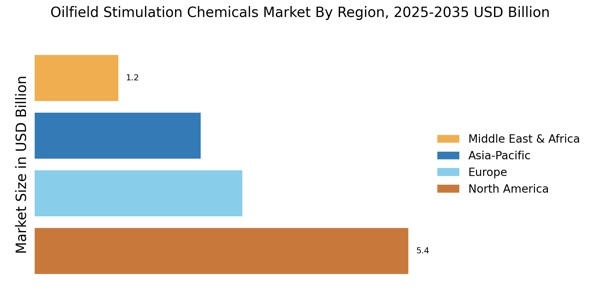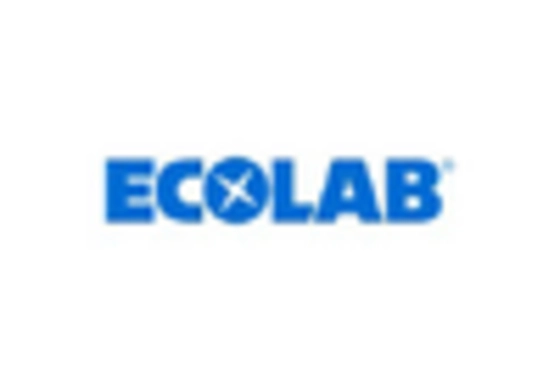The Oilfield Stimulation Chemicals Market is currently characterized by a dynamic competitive landscape, driven by the increasing demand for enhanced oil recovery and the need for efficient drilling operations. Key players such as Halliburton (US), Schlumberger (US), and Baker Hughes (US) are at the forefront, each adopting distinct strategies to maintain their market positions. Halliburton (US) emphasizes innovation in chemical formulations, focusing on developing environmentally friendly solutions, while Schlumberger (US) leverages its extensive global footprint to enhance service delivery and operational efficiency. Baker Hughes (US) appears to be concentrating on digital transformation, integrating advanced analytics into its service offerings to optimize performance and reduce costs. Collectively, these strategies not only enhance individual company profiles but also intensify competition within the market, as firms strive to differentiate themselves through technological advancements and sustainable practices.
In terms of business tactics, companies are increasingly localizing manufacturing to reduce lead times and enhance supply chain resilience. This approach is particularly evident in regions with high oil production, where proximity to operations can significantly impact service delivery. The market structure is moderately fragmented, with several players vying for market share, yet the influence of major companies remains substantial. Their ability to innovate and adapt to changing market conditions shapes the competitive dynamics, fostering an environment where agility and responsiveness are paramount.
In August 2025, Halliburton (US) announced a strategic partnership with a leading technology firm to develop AI-driven solutions for real-time monitoring of stimulation processes. This collaboration is poised to enhance operational efficiency and reduce downtime, reflecting Halliburton's commitment to integrating cutting-edge technology into its service offerings. Such initiatives not only bolster Halliburton's competitive edge but also signal a broader industry trend towards digitalization and automation in oilfield operations.
Similarly, in July 2025, Schlumberger (US) launched a new line of eco-friendly stimulation chemicals aimed at reducing environmental impact during hydraulic fracturing. This move aligns with the growing emphasis on sustainability within the industry, as stakeholders increasingly prioritize environmentally responsible practices. By positioning itself as a leader in sustainable solutions, Schlumberger is likely to attract clients who are increasingly scrutinizing the environmental implications of their operations.
In September 2025, Baker Hughes (US) unveiled a comprehensive digital platform designed to optimize chemical usage in oilfield operations. This platform utilizes machine learning algorithms to analyze data and recommend optimal chemical formulations based on specific well conditions. The introduction of such technology not only enhances operational efficiency but also reflects Baker Hughes' strategic focus on leveraging data analytics to drive performance improvements. As companies continue to invest in digital solutions, the competitive landscape is expected to evolve, with data-driven decision-making becoming a critical differentiator.
As of October 2025, the Oilfield Stimulation Chemicals Market is witnessing a shift towards digitalization, sustainability, and AI integration, which are defining current competitive trends. Strategic alliances are increasingly shaping the landscape, enabling companies to pool resources and expertise to address complex challenges. Looking ahead, competitive differentiation is likely to evolve from traditional price-based competition to a focus on innovation, technology integration, and supply chain reliability. Companies that can effectively navigate these trends will be better positioned to thrive in an increasingly competitive environment.


















Leave a Comment